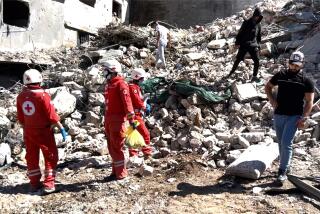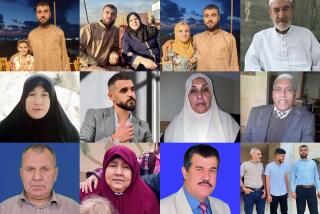Thousands of Orphans, Amputees : Both Sides in Brutal War Target Angola’s Civilians
- Share via
BIONGUE, Angola — Fehina Teheia was walking home with her children after a day’s work in the cornfields outside her village in central Angola when “the earth suddenly blew up.”
She had stepped on a land mine buried along the trail to the fields near Sambambi in Huambo province. Three of her children--3, 4 and 5 years old--were killed. Her left foot was blown off, and her body was laced with shrapnel.
“I lay there the whole night in the pouring rain with the bodies of my children, my poor children, around me,” Teheia recalled. “I tried to remember prayers, but the pain was too great.”
Lourenco Chimbango, accompanied by his children, was on his way to the fields at another village when he, too, stepped on an anti-personnel mine, then fell on a second. Three of his children, aged 11, 12 and 14, were killed. He lost both his legs and lay on the little-used footpath for three days before he was rescued.
Antonio Samukonga was asleep with his family when mortars began falling on his village near Menongue in southeastern Angola. One shell hit just outside his hut, killing his wife and shattering his left leg. The death toll in the attack was 54, all of whom Samukonga described as farmers and craftsmen.
Biongue, a settlement of 2,000 in southeastern Angola, is full of such stories--testimony to the brutal civil war between Angola’s Marxist government in Luanda and the guerrillas of the National Union for the Total Independence of Angola.
More than 60,000 people have died in the 12-year conflict, according to government figures; the rebels say the actual toll is undoubtedly higher. Two-thirds of the casualties on each side are said to be civilians, most often women and children.
“In its ferocity, this war is like those in medieval times, but the modern weapons that are being used make it far more devastating,” a medical worker with the International Committee of the Red Cross said in Luanda earlier this year, asking not to be quoted by name.
“The carnage--there is no other word for it--is appalling, and what is happening to the people of Angola is heart-breaking.”
690,000 ‘Displaced Persons’
Angola has at least 20,000 orphans, according to international relief agencies. There are an estimated 30,000 amputees, half of them women and children. And about 690,000 people, three-quarters of them women and children, have been driven from their homes by the fighting and are classified as “displaced persons” by the United Nations; more than 60,000 others have sought sanctuary as refugees in neighboring countries.
The government and UNITA, as the guerrilla movement is known, accuse each other of waging war by atrocity--massacres of civilian supporters, indiscriminate bombardments of villages, attacks on meager medical facilities and the laying of anti-personnel mines along paths used by farmers.
“More and more attacks are made especially on women and children in order to terrorize the population and create instability,” said a recent report on the war by UNICEF, the United Nations Children’s Fund. The report put most of the blame on the guerrillas.
Miguel de Carvalho, the government’s press director in Luanda, who was crippled during Angola’s war for independence from Portugal, went further in an interview earlier this year: “UNITA, as it murders and maims, purposely picks on the defenseless, knowing that the people support us and that our forces are too strong for them. . . . This is not a political struggle for them--it is butchery by bandits and terrorists.”
But Dr. Andelino Manassas, director of UNITA’s 200-bed hospital at Jamba, the rebels’ headquarters near here, said more than half of his patients are civilian victims of government military actions and that the proportion is growing.
“The concept of ‘civilian noncombatant’ seems to have lost all meaning for enemy forces,” Manassas added. “Half of our beds are filled with amputees, mostly villagers who have stepped on the mines planted by the (government) troops.”
Common as Measles
Shrapnel wounds are nearly as common as measles among the children of Angola, another Jamba hospital worker commented. Luanda’s Josina Machel Hospital routinely does four or five amputations on land-mine-injured civilians each morning, and children as young as 3 and 4 with only stumps of legs are frequently seen in the country’s towns and villages.
“Our children are the true victims of this war,” Madalena Ruth Ndashala, information secretary of UNITA’s women’s organization, said in an interview at Jamba. “They should be the future of the country, but they are dying by the hundreds, by the thousands.
“When the Cubans or Russians bomb our villages, most of the victims are children. Sometimes they live but lose their mothers and fathers. Their little bodies are so frail that when they step on the mines, they die.”
And the villagers at Biongue, all UNITA supporters, tell tales of savagery by government troops so matter-of-factly that combat veterans often cry as they listen.
Veronica Kaanli, 19, recalled how Cuban troops fighting with Luanda’s forces raided her village of Chiuka in Bie province in central Angola two years ago, methodically killing all the men and burning their bodies. The women were then marched away, she said, and most were not seen again.
A Cuban soldier killed her pregnant sister during the march, Kaanli continued, by cutting open her stomach with a bayonet and then crushing the head of the fetus with the heel of his boot.
“Our village supported UNITA, and so the (government) eliminated it,” she said. “Most of our people were murdered. Nobody lives at Chiuka any more.”
One of Kaanli’s legs was amputated by a Cuban surgeon because of an injury suffered during the forced march. Later, a friend was carrying her across a river when he stepped on a mine and was killed. Two passing UNITA guerrillas eventually rescued her and arranged for her to come to the movement’s center for war invalids in the bush at Biongue.
‘Worst Crimes Since Nazis’
“How can they call themselves a government when they use such brutal methods, such terrorism to try to keep their hold on power?” Col. Ernesto Mulato, a senior UNITA official, said, denouncing the ruling Popular Movement for the Liberation of Angola. “They are guilty of the worst war crimes since the Nazis.”
Samukonga, whose village lies between government and UNITA lines near Menongue, said the heavy mortar bombardment there and a follow-up government raid were intended solely to “punish” villagers for their support of the rebels.
“The government wants people to understand that to support UNITA is to die,” he said, “and so they have their troops kill a lot of people to make sure we get the message.”
Chimbango argued that government troops--not UNITA--were responsible for mining the grain fields and paths near his village.
“The government is trying to force those sympathetic to UNITA off their land so they can take it over and get that food,” he declared. “Well, in my case, they succeeded--here I am, doing very little in Biongue, no longer growing food for my family or my village or UNITA. . . . Anyone who looks at my field or my house says to himself, ‘That was old Chimbango’s--and you know what happened to him.’ And so terror works.”
Equally gruesome allegations of UNITA atrocities are heard, however, in government hospitals, whose orthopedic wards and physiotherapy centers are also filled with amputees.
An independent assessment of guilt or responsibility in such emotional circumstances is very difficult to get.
UNITA guerrillas, the government says, plant mines in farm fields to prevent peasants from harvesting their crops. Terror is the traditional weapon of rebels, it adds, and UNITA uses such methods to convince the rural population that the government cannot protect them.
Government troops, according to UNITA, frequently round up villagers suspected of supporting the rebels and supplying them with food and confine the peasants to fenced hamlets, which are surrounded by mine fields to isolate them further. More mines are planted along routes that the guerrillas might use and in disputed areas, according to UNITA.
Each side denies the other’s allegations but acknowledges efforts to disrupt the enemy supply lines and to deny the other territory wherever possible, particularly in such hotly contested provinces as Huambo and Bie in central Angola.
Hitting Economic Targets
Jonas Savimbi, UNITA’s president, said in an interview at his Jamba headquarters that his guerrillas, increasingly active in the northern, central and western areas of the country, regularly attack economic targets, such as coffee and sugar plantations, and major transport routes as well as military and government facilities. However, he said, his commanders are under orders to avoid civilian casualties.
In the past, UNITA guerrillas spread small, anti-personnel mines to prevent government troops from pursuing them after their raids, but Savimbi, alarmed by possible civilian casualties, ordered this tactic halted wherever civilians were present in the area.
“War is an ugly affair, to be sure, but what ultimate objective justifies the indiscriminate use of anti-personnel mines that have as their one objective making life miserable?” a senior U.N. official commented in Luanda. “What type of war objective could a movement have that it willfully mutilates people, especially women and children?”
Michael Parks, The Times’ bureau chief in Johannesburg, was recently on assignment in Angola.
More to Read
Sign up for Essential California
The most important California stories and recommendations in your inbox every morning.
You may occasionally receive promotional content from the Los Angeles Times.










